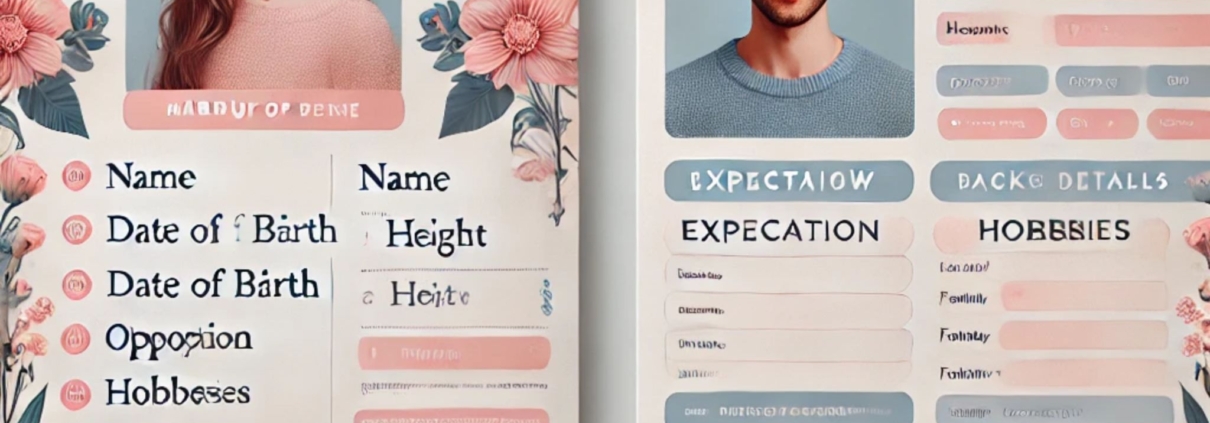Start with a Simple Biodata for Marriage Format
In India, where arranged marriages still hold a strong cultural presence, the first impression often starts not with a face-to-face meeting, but with a document — the marriage biodata. Think of it as your matrimonial resume, a concise reflection of who you are, what you seek, and what makes you a suitable life partner.
Creating a simple biodata for marriage format is not just about filling in boxes. It’s about presenting your most authentic self in a manner that is respectful, clear, and appealing to prospective families. Whether you’re preparing it for the first time or refining one that already exists, this guide will help you understand the structure, purpose, and best practices to get it right.
What is a Marriage Biodata?
A marriage biodata is a personal profile typically used in arranged marriage settings. It includes essential information such as name, age, height, education, profession, religion, and family background. In addition to these factual details, it may include your expectations from a partner, lifestyle choices, and sometimes even a recent photograph.
This document acts as a foundation for families to begin the matchmaking process. It’s not a detailed biography but a carefully curated snapshot that conveys who you are and what you’re looking for in a spouse.
Why Simplicity Matters
In a world overloaded with information, simplicity is powerful. A simple biodata for marriage format is more likely to be read completely, understood clearly, and appreciated for its neatness. Overcomplicating your biodata with too many design elements, long paragraphs, or flowery language can distract from what really matters: your personality, values, and compatibility.
Here are some benefits of keeping it simple:
- Easy readability: Family elders or matchmaking agents will find it easy to read.
- Faster shortlisting: When information is clear, decisions can be made more quickly.
- Better impressions: Clean formatting reflects sincerity and attention to detail.
Key Sections of a Simple Marriage Biodata
If you’re unsure where to begin, start by organizing your biodata under the following sections. These are universally accepted categories and help maintain consistency:
1. Basic Information
- Full Name
- Date of Birth / Age
- Height & Weight
- Religion / Caste / Community
- Languages Known
- Marital Status (Unmarried/Divorced/Widowed)
2. Educational Background
List your qualifications in reverse chronological order. Mention your school, college, university, and any certifications.
3. Professional Details
Include your job title, company name, work location, and income (optional). If you own a business or freelance, briefly explain the nature of your work.
4. Family Details
Provide a snapshot of your family. Include your parents’ names and occupations, the number of siblings, and their marital/professional status.
5. Lifestyle & Interests
Mention hobbies, travel interests, food preferences (vegetarian/non-vegetarian), and religious/spiritual inclinations. This helps gauge compatibility beyond academic or professional status.
6. Partner Preferences
This section outlines what you’re looking for in a partner — education, profession, values, lifestyle, or even community preferences (if applicable). Be honest but not overly specific.
7. Photograph (Optional but Recommended)
Attaching a recent, well-lit, formal or semi-formal photograph adds credibility. It also increases the chances of your biodata being shortlisted.
Dos and Don’ts for a Marriage Biodata
Dos:
- Keep the format neat and aligned.
- Use bullet points where appropriate.
- Maintain a formal tone but stay genuine.
- Limit to 1 or 2 pages maximum.
- Use a professional font like Arial or Calibri.
Don’ts:
- Avoid flashy fonts or bright background colors.
- Don’t exaggerate your achievements or expectations.
- Refrain from including confidential documents like ID proofs.
- Don’t write long paragraphs; keep it brief.
Digital vs. Printed Biodata
Today, most biodata sharing happens digitally through matrimonial websites, WhatsApp, or email. A well-formatted PDF version is ideal for online sharing. However, you may still want to print hard copies for traditional matchmaking events or family elders who prefer physical documents.
If you’re submitting your biodata through an app or platform, make sure it matches the guidelines set by that platform. Some allow you to upload your own format, while others use predefined templates.
Tailoring for Specific Communities
India’s rich diversity means that different communities may have specific preferences when it comes to biodata content. For example, a shadi biodata format in a Muslim or Urdu-speaking family might include additional sections such as religious observance, family lineage, or mahr expectations. Similarly, South Indian or Gujarati formats may include horoscopes or nakshatras.
While the core structure remains the same, respecting these cultural details shows thoughtfulness and earns family respect.
Common Mistakes to Avoid
- Using casual language: Avoid slang or informal tone. Treat your biodata as a professional profile.
- Skipping family information: In arranged setups, family background is important.
- Being too vague or too specific: Balance is key when mentioning partner preferences.
- Sending unedited drafts: Spelling or grammar errors can be off-putting.
- Including unnecessary details: Avoid listing childhood achievements or outdated academic information.
Final Thoughts
Starting with a simple biodata for marriage format is the smartest way to present yourself in India’s matrimonial space. It acts as a bridge between you and your future partner’s family, and sometimes, between two different worlds.
By focusing on clarity, structure, and sincerity, your biodata becomes more than just a document — it becomes a doorway to a meaningful relationship.
Whether you’re using it on a matrimonial platform, through a family priest, or handing it to relatives, make sure it reflects who you are, not just what you’ve done. A well-made biodata for marriage can open up conversations that eventually lead to a lifelong bond.



Leave a Reply
Want to join the discussion?Feel free to contribute!